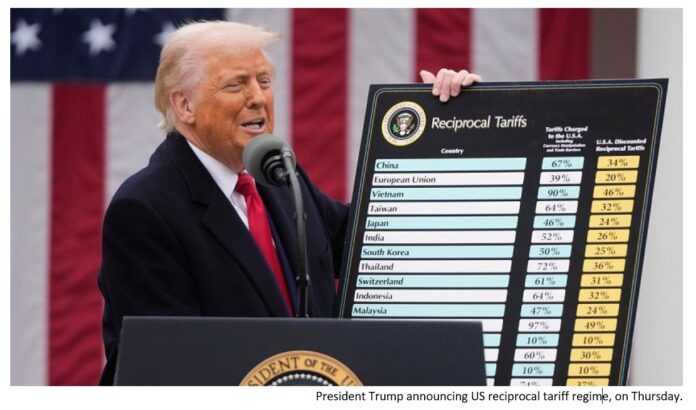By Vishvanath
What was feared has come to pass. The US has increased tariffs on Sri Lankan goods to 44%. The Trump administration has described the unprecedented tariff hike under its new trade policy as a reciprocal measure in response to Sri Lanka’s 88% trade barriers on imports from the US. Sri Lanka has been placed among the five countries facing the highest US tariff rates globally.
Trump announced a baseline 10% tariff on all imported goods, coupled with a reciprocal tariff equal to 50 percent of what other countries levy on US exports. The list features a number of close US allies, who were disappointed to be included. They include the European Union, Japan and South Korea. In his speech explaining why his government had decided on reciprocal tariff, Trump went on to claim that although it was popularly thought that the European Union was a friend of the US, it ripped off the US!
Some US allies reacted strongly to the tariff hikes, while others took a timid approach. According to the US News, many ultimately have been left scratching their heads at what Trump’s ultimate goal is with the tariffs, which could potentially lead to a global trade war that has some economists raising the odds of a recession within the next 12 months.
Curiously, Trump left out some countries such as Russia, Belarus, Cuba and North Korea from reciprocal tariffs. That move surprised many. However, The New York Times explained why he had done so, quoting an unnamed White House official; those countries already face ‘extremely high tariffs and previously imposed sanctions preclude any meaningful trade with them.”
Speculation had been rife for weeks that the US would hike its tariffs, and Sri Lanka would also be affected adversely, but nobody expected the Trump administration to adopt such a drastic reciprocal measure to rectify its trade imbalance. It was thought that Washington would take Sri Lanka’s economic crisis into consideration and grant some relief. The Sri Lankan government is said to be hopeful that it may be able to obtain some relief from Washington on account of the country’s ongoing IMF bailout programme.
No sooner had President Trump announced the new US tariffs, which sent many countries reeling than President Anura Kumara Dissanayake appointed an expert committee to study the tariff structure and recommend how Sri Lanka should handle the situation. It consists of Senior Economic Advisor to the President Duminda Hulugamuwa, Secretary to the Ministry of Finance Mahinda Siriwardana, Governor of the Central Bank Dr. Nandalal Weerasinghe, Secretary to the Ministry of Trade A. Wimalaneththiraja, Chairman of the Export Development Board Mangala Wijesinghe, Senior Director General (Bilateral) at the Ministry of Foreign Affairs Dharshana Perera, Chief Economic Policy Advisor to the Ceylon Chamber of Commerce Shiran Fernando, Group Chief Executive Officer of Brandix Ashroff Omar, Co-Founder of MAS Holdings Sharad Amalean, Managing Director of Lanka Garments Saif Jafferjee and Nilanthi Weliwe representing Michelin Lanka Pvt Ltd were present at the meeting.
Minister of Labour and Deputy Minister of Economic Development Dr. Anil Jayantha Fernando and Deputy Minister of Finance and Planning Dr. Harshana Suriyapperuma also participated in the discussion the committee had on Thursday. The committee is expected to submit its report shortly.
Foreign Minister Vijitha Herath has gone on record as saying that a high-level Sri Lankan delegation will visit Washington to discuss with the US government officials on US tariffs on goods from Sri Lanka.
The United States is Sri Lanka’s most important export destination. It accounted for 23% of Sri Lanka’s total merchandise exports in 2024. Sri Lanka’s apparel industry is expected to suffer a crippling blow owing to the new US tariffs. It accounted for about 70% of Sri Lanka’s exports to America to the tune of USD 2.9 billion in 2004.
The US tariff hike could not have come at a worse time for Sri Lanka, which is struggling to emerge from its worst-ever economic crisis, which compelled it to resort to a sovereign debt default and adopt austerity measures. Its foreign reserves have been improving, with its garment sector recovering. Its exports, especially garments, will become less competitive in the US due to the new tariff regime, and a possible sharp drop in orders for its garments will plunge the apparel sector into a crisis and threaten tens of thousands of jobs. The apparel sector employs more than 300,000 workers directly and hundreds of thousands more individuals indirectly. If this vital sector shrinks, there will be layoffs, leading to socio-political problems.
According to official statistics, Sri Lanka’s current unemployment rate stands at 4.7%, with the youth unemployment remaining as high as 23.4%. Female unemployment is 6.7%. There are about 400,000 unemployed persons in the country. Job losses in the apparel sector will affect mostly women and aggravate an already bad situation.
The NPP government is doing its utmost to persuade the Trump administration to reduce or waive tariffs on Sri Lankan goods on humanitarian grounds. It is leveraging the ongoing US-backed IMF programme to gain relief. There is said to be a fighting chance that Sri Lanka can have its appeal considered favorably. Unless its efforts reach fruition, the Sri Lanka, especially the incumbent government will have mega issues to contend with on both economic and political fronts.
Opposition Leader Sajith Premadasa lost no time in flaying the NPP government for having let the grass grow under its feet in spite of warnings of a US tariff hike. He said the SJB’s annual convention on Thursday (03) that he had urged the government to adopt precautionary measures months before but to no avail. Signs are that the US tariff hike and its economic fallout will be a key issue in the upcoming local government polls. It is unlikely that the government and the Opposition will adopt a consensual approach to the problem.
Perhaps, it will be a couple of months before the full impact of the new US tariffs on the Sri Lankan economy is felt, provided the government fails to secure some relief from Washington. However, a setback in the export sector will adversely affect the government’s overall performance and its ability to live up to people’s expectations in the long run.
Future governments, too, will not be able to avoid the economic fallout of the US tariff hikes. It will be advisable for them to sink their differences and make a concerted effort to secure better trade terms from Washington, and, most of all, strengthen the Sri Lankan economy to absorb shocks from tariff hikes and other factors that adversely impact the domestic export sector and drive import prices up.



 Logging you in...
Logging you in... Loading IntenseDebate Comments...
Loading IntenseDebate Comments...

